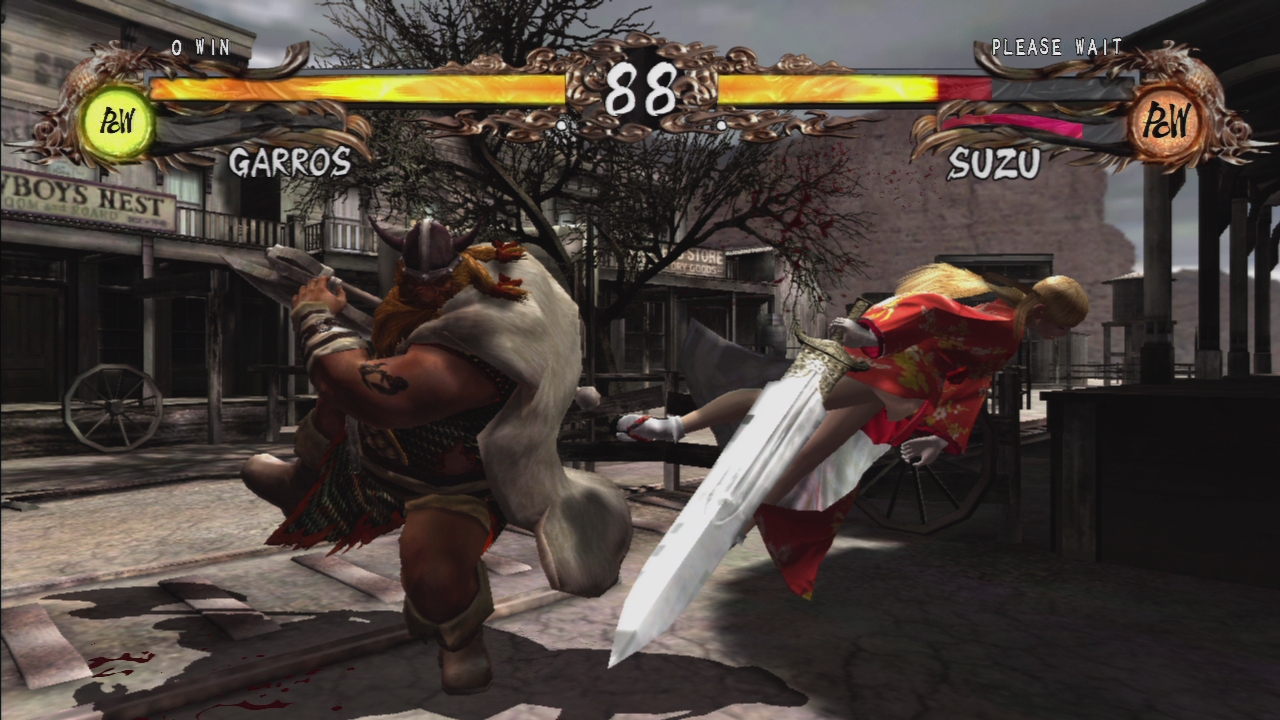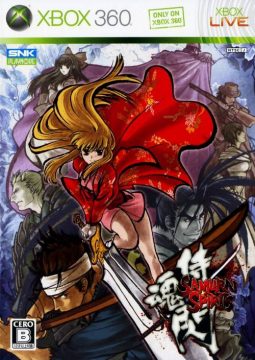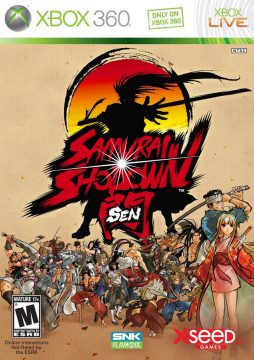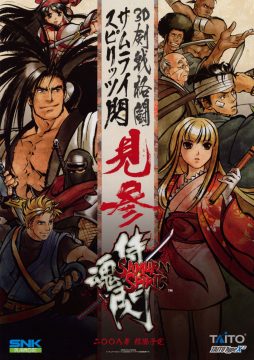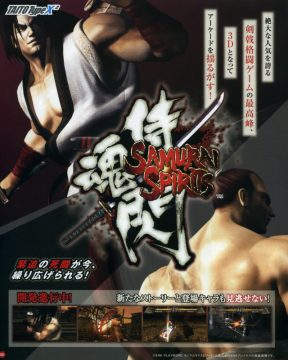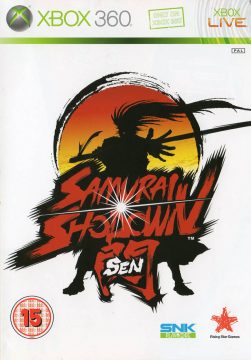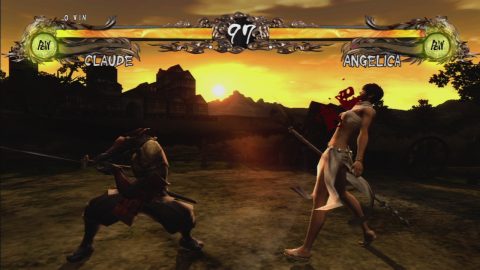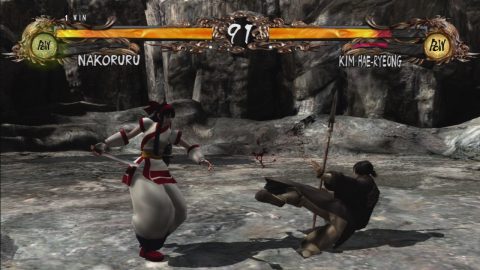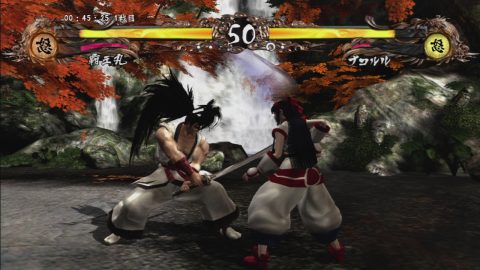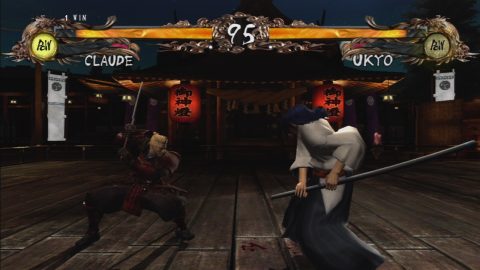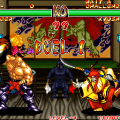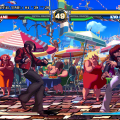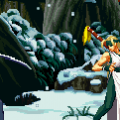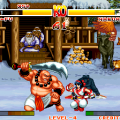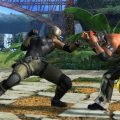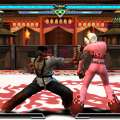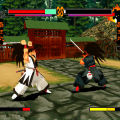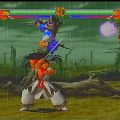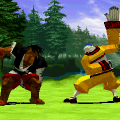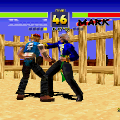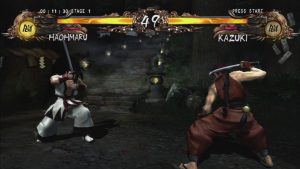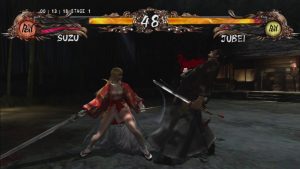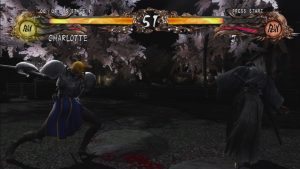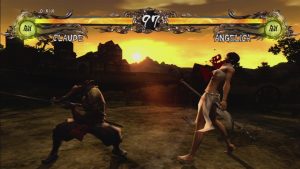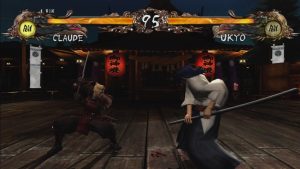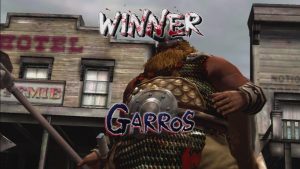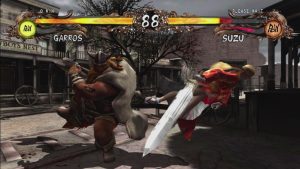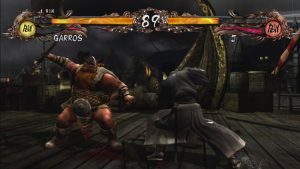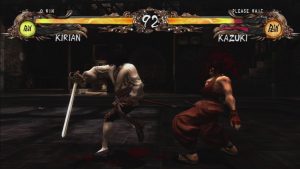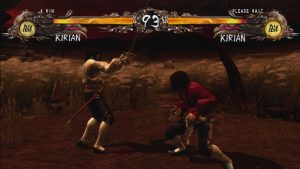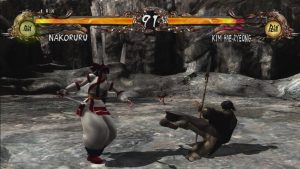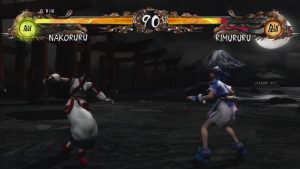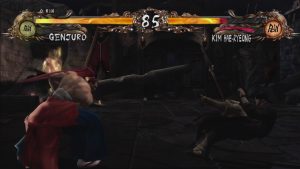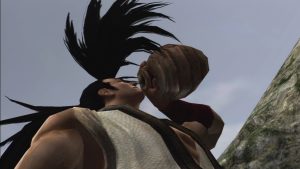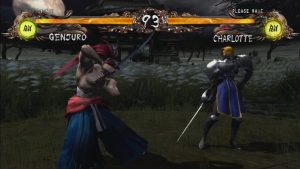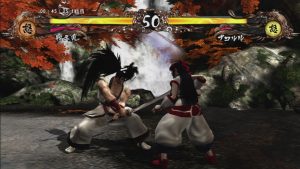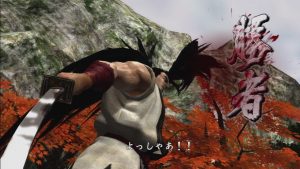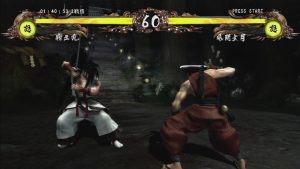- Samurai Shodown (Intro / Characters)
- Samurai Shodown
- Samurai Shodown II
- Samurai Shodown III
- Samurai Shodown IV
- Samurai Shodown V
- Samurai Shodown V Special
- Samurai Shodown 64
- Samurai Shodown (Neo Geo Pocket)
- Shinsetsu Samurai Spirits: Bushidou Retsuden
- Samurai Shodown VI
- Samurai Shodown Slash
- Samurai Shodown Sen
- Samurai Shodown 64: Warriors Rage
- Samurai Shodown: Warriors Rage
- Nakoruru: Ano Hito Kara no Okurimono
- Samurai Shodown (Anime)
Sometime before 2008, SNK Playmore decided it was time to try bringing the series into the HD era as a true 3D fighting game. This was their second attempt at this: the first Hyper Neo Geo 64 game allowed sidestepping, although its use was limited by a gauge. The result was Samurai Spirits Sen (“Sen” meaning a certain strategic position in swordfighting). With Namco’s Soul Calibur series having long since overtaken Samurai Spirits as the most popular weapons-based fighter, SNKP might have hoped to challenge its popularity by making a game with a similar feel and many of the same elements. Street Fighter IV hadn’t yet arrived on the scene, and the prospect of making a two-dimensional fighter with full 3D graphics had yet to be proven. SNKP probably realized their lack of experience with true 3D games, and the poor quality of their more recent attempts (notably Metal Slug 3D and the original KOF: Maximum Impact). So they turned to K2 LLC to develop the game under supervision. K2 was responsible for many of the Tenchu games, all of which prominently feature ninjas, samurai, and swordplay. It should always ring alarm bells in the minds of fans whenever a major new entry in a classic series is outsourced, but K2 was a perfect fit for the game and did a completely competent job.
Samurai Shodown Sen‘s story is such a huge break with series canon that it logically can’t be part of it. It takes place in the early 1800s – the same period as the PlayStation Warrior’s Rage – but all the returning characters are depicted in the usual manner, and haven’t aged one bit. So the only explanation is that it’s part of a separate timeline where the characters were born later. With an opening FMV that recreates the cherry tree-slicing intro of the first game, Senmight be intended as a reboot of the series. But even then, the “Wild West” frontier setting depicted in one stage wouldn’t exist for some time. At any rate, the plot centers around Golba, a mysterious figure with close ties to the American Revolution. He commands a secret Nazi-esque organization with the goal of gaining control of every major world power’s government. Many of the characters have become aware of his organization for various reasons, and are journeying the globe to track him down, whether for justice or the sake of revealing their unknown pasts. The others are just along for the ride. Overall, the story takes more of a backseat role than in previous games, which is probably for the best, since it isn’t too interesting. Every character has fully voiced and animated cutscenes before each boss, and some of these are quite good, but the openings and endings are simply blank screens with narrated text, and there’s no pre-fight banter.
The returning characters are all popular series veterans: Haohmaru, Genjuro, Nakoruru, Rimururu, Ukyo, Kyoshiro, Jubei, Wan-Fu (with his SS1 scimitar back), Galford, Hanzo, Charlotte, Kazuki, and Sogetsu. Joining them are 13 newcomers, including three bosses. While they fail to live up to the standards of iconic character design set by the earlier games, they are still fun to play as, and have distinct personalities. Regrettably, there are many “clones,” who even share each other’s idle stances. But in most cases, they are still far more differentiated than in early Tekkengames, with the bulk of each character’s move set being unique. It wouldn’t be fair to compare the clones to the Slash/Bust system either, since they all have different normals. There’s no comeback for fan favorites Earthquake and Cham Cham, but they would have been quite at odds with the game’s realistic aesthetics – the Viking character Garros already is. Sen definitely seems to favor its returning cast a bit, since they tend to have larger and more versatile movesets. This doesn’t mean that the newcomers don’t have depth, though.
The portrayal of the returning cast is interesting. Since projectiles are not terribly workable in 3D fighters, nearly all have been eliminated or modified into close-range moves, as with Haohmaru’s Hurricane Slash. The only true projectiles left are Galford and Hanzo’s fake-teleport shuriken, Galford’s attack with Poppy, Hanzo’s rage move, and Draco’s gun attacks. Most non-projectile specials and rage moves are retained in some form, and have been integrated quite well into the third dimension. The controls have been completely overhauled to accommodate this added dimension. There are now two slash buttons for horizontal and vertical slashes and one kick button, much like in Soul Calibur. Power slashes also come in horizontal and vertical forms. Horizontal power slashes are always faster and weaker than vertical ones. There’s a strong focus on free-form juggle combos, with many attacks being obviously designated as “launchers.” Characters can also be knocked against walls and comboed from there. The fourth button is dedicated to throws. Unlike in Soul Calibur, guarding is handled by moving backwards, not by a button press. There isn’t any 8-way run either, with the sidestep being your only option for 3D movement.
Every character has the same standard throw with the same animation: a simple knee to the stomach. Sadly, it is highly abusable, at least until your opponent learns to escape it, and does far too much damage for what it is. However, there are character-specific command throws and a few oddball moves that use the throw button. It’s also used to activate a counter move that works exactly like Guard Impact in Soul Calibur, although the timing is much stricter. Additionally, characters can no longer “clash” or drop their weapons – implementing these mechanics effectively in unrestricted 3D space would have been next to impossible. Predictably, the judge is also absent. There are three completely new system elements: Guard Shatter moves, Fastest Input, and Just Input. Guard Shatter moves are performed by pressing all four buttons at once, and are equivalent to the flaming-weapon attacks of Soul Calibur: extremely slow, powerful and unblockable. Fastest Input only applies to two special moves of Haohmaru, and increases their power if you are able to input the commands ridiculously quick. Just Input applies to a wide range of special moves, which are indicated by blue sparks. It modifies the effect and timing of the move if you press the command’s button again during the animation. Sadly, none of these are terribly useful to know.
Rage Mode has been changed up yet again. The bar still fills up as a character is hurt, but you don’t have to activate it right away. Pressing the three attack buttons together with a full bar will trigger a Rage Explosion, activating Rage Mode and pushing your opponent away a bit. Like in the classic games, you have increased attack power and can use your rage move as many times as you want, though it wears off quite a bit faster. Unfortunately, some rage moves are nearly useless: Hanzo’s is an unblockable fire wave with huge range, but to make it do any damage takes far too much charging. On the other hand, some are completely broken, such as J’s and Kim’s. There is also an extremely powerful, though not instant-killing, move that all characters can perform: the Fatal Flash. It can only be activated once per round when your health is low. Your character will perform a slow elbow bash with obvious telegraphing, and if it connects, a brief cutscene in heavily desaturated black and white will play. Regrettably, there are no fatalities associated with this move, it leaves you wide open, and it’s practically impossible to actually land in a match. This could have been a legitimate comeback mechanic, but it’s nothing more than a throwaway gimmick. The fighting engine is overall a lot slower and more methodical than Soul Calibur‘s, and while it isn’t as fluid or consistently exciting, it prevents mashing from being a viable strategy, and encourages more thoughtful play. Whiffed moves and turtling are often quickly and severely punished.
The graphics have been described as upscaled PlayStation 2 fare, and while this isn’t entirely untrue, it does no justice to the stellar aesthetics or immersive atmosphere. Most of the characters look rather rough up close, with skin resembling pallid clay and some strange faces, although this is less apparent at a distance. Their attire is also lacking in detail. But the environments are some of the most gorgeous and believable to grace a 3D fighter, despite a fairly low polygon count, and there’s a huge number of them. They include a great recreation of the iconic beach stage from Samurai Shodown II and IV, with jagged rocks on the shore and torii gates stretching into the distance. There’s castle ruins with the remnants of a recent battle, an ominous Japanese shrine in the dark, torchlit woods, and the dance floor of a rustic Spanish restaurant. The best is a beautiful vista of a French mansion on a hill at sunset. Many stages even have multiple versions for different times of day, and one is infinitely large, like those in the first four Tekken games.
The only average stage is the Wild West frontier town, with some ugly buildings, and it’s still kinda funny to see samurai duking it out in such a setting. All of these are complemented by tastefully subdued color palettes and light effects. In an era where every 3D fighter from Soul Calibur to Virtua Fighter favors the most outlandish settings and silly customizable costumes, it’s refreshing to see one with a more cohesive aesthetic and a bit more class. While not especially memorable, the music is composed to high standards, and effectively evokes the atmosphere of its stage, always with appropriate instruments: The Japanese stages have plenty of shamisens, taiko drums and shakuhachi flutes, a Spanish guitar is present in the restaurant, and there’s even a fiddle for the Wild West. There aren’t any classic themes, however.
The fatalities were a back-of-the-box selling point for the Western releases, and they certainly don’t disappoint. If the final blow of a match is a power slash or a rage move that deals slash damage, the victim will meet one of several grisly fates, depending on which part of their body was hit. A stab in the gut causes the unlucky duelist to pour fountains of blood from their stomach, as they slowly stagger over. A severed hand ends with the victim clutching the bleeding stump, rolling in agony, as their weapon sticks in the ground with the hand still attached. You can even be sliced in half along the waist, sending both halves flying apart. Unlike earlier Samurai Shodown games, Sen doesn’t linger on the details of these events, and they happen immediately after a hit, with no elaborate theatrics or “Finish Him” nonsense. They’re simply jarring and brutal, and it often really feels like you just fought a duel to the death. Unfortunately, there are no character-specific fatalities (or suicides, for that matter), but it never feels like something’s missing. While most of the game’s animations were clearly posed by hand, the fatalities and character intros seem to have been motion-captured, which gives them a realistic weight.
Samurai Spirits Sen was released to Japanese arcades in 2008, where it was largely met with indifference and ignored in favor of flashier, well-established 3D fighters like Tekken 6. The censorship issue may have contributed to its unpopularity – people expect at least a few splashes of blood from a Samurai Spirits title, and Tenkaichi had already disappointed in this respect. Sen received little exposure or competitive play, although there were a small number of dedicated fans uploading matches to video sites from the very beginning. An American arcade release with a TBA date is listed on some sites, but it clearly never happened, given that the Western arcade scene is on its deathbed. For the home port, SNKP must have decided there wasn’t enough of a market for the game to justify releasing it on both consoles, so they went with the Xbox 360. It shares the Windows PC architecture of the Type-X2 arcade hardware, making for an easy porting job; its Japanese user base is generally more hardcore and receptive to niche fare, and Xbox Live is agreed to be a superior online experience. So outside of the arcade kit, the 360 is the only option for playing Sen.
The 360 port was first released in Japan and Korea in December 2009. It’s a rather bare-bones port, with the only additions being the usual survival and training modes, playable versions of Draco and Golba, and Xbox Live functionality. Thankfully, it’s still a lot more full-fledged than SNKP’s infamous KOF XII ports. It was originally slated to be published in the US by Ignition Entertainment under the vapid and cliched title of Samurai Shodown: Edge of Destiny, which sounds like an American anime VHS from the nineties. There was even a trailer released using this name. Apparently Ignition wasn’t confident enough in the game, so it was passed on to XSeed, who wisely kept the original title, aside from the usual “Shodown” replacement. However, SNKP insisted on localizing the game themselves, leading to the awkwardly literal story text that’s typical of the company. Although there is something comforting about seeing SNKglish like “Dancing man in death place” in a game from 2009. The announcer is replaced with an amateurish, bored-sounding English voice, but thankfully, the story narration and characters are not dubbed. The Japanese announcer can be restored with a language setting, but doing so changes all non-menu text to Japanese. An identical European release by Rising Star followed shortly after XSeed’s. Finally, Sen arrived on the 360’s Games on Demand download service in Japan and America late in 2011.
Due to the graphic nature of the fatality sequences, which were not deemed acceptable for an arcade environment, the Japanese release was completely censored. Fatalities will not occur under any circumstances, and all blood effects are removed. This carried over to the Japanese 360 port, which only received a CERO B (12 and up) rating, as opposed to its adult rating in the US and Korea, and 15+ rating in Europe. Thankfully, the Japanese 360 release is not treated as a separate game, and is fully compatible with the other versions on Xbox Live matches. Surprisingly, the netcode is quite good, and little lag is present on a good connection even when playing across continents. Switching the language setting to Japanese in the international versions does not censor the game. Curiously enough, the Korean version is uncensored, despite the country having an even stricter rating system than Japan.
Samurai Spirits Sen is not a masterpiece, or anywhere near as groundbreaking as the early games. It’s heavily derivative of Soul Calibur, certain moves are too abusable and damaging, certain characters are overpowered (particularly Ukyo and Kyoshiro), animations are re-used too often, and many characters lack good mix-up options. But something about it remains compelling. It might just be that it’s SNKP’s first real attempt at a game of the HD generation, or the fact that there are so few other alternatives to Soul Calibur and Tekken these days, when in the 32-bit era every major console was stuffed to the gills with 3D fighters. Whatever the case, Sen is a thrilling and engrossing package that any fan of the series with a 360 should not ignore, especially considering its current bargain-bin price. It’s really too bad that it will likely never receive an upgrade or proper follow-up, given its negative reception.
